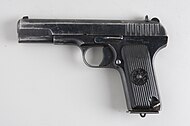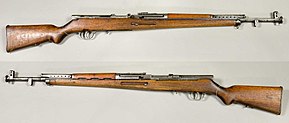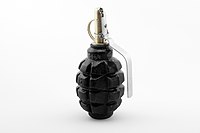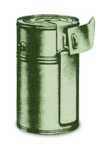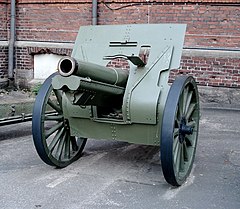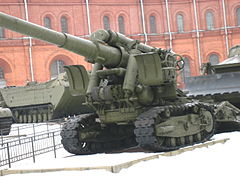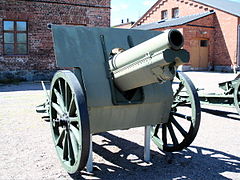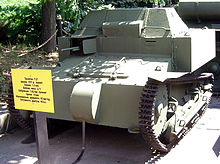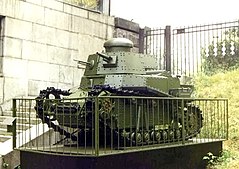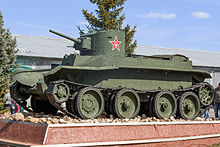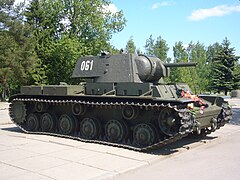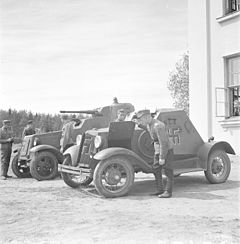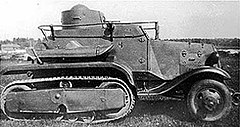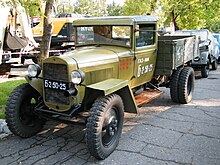
The T-26 tank was a Soviet light tank used during many conflicts of the Interwar period and in World War II. It was a development of the British Vickers 6-Ton tank and was one of the most successful tank designs of the 1930s until its light armour became vulnerable to newer anti-tank guns. It was produced in greater numbers than any other tank of the period, with more than 11,000 units manufactured giving it the title of the most produced tank during the interwar period. During the 1930s, the USSR developed 53 variants of the T-26, including flame-throwing tanks, combat engineer vehicles, remotely controlled tanks, self-propelled guns, artillery tractors, and armoured carriers. Twenty-three of these were series-produced, others were experimental models.
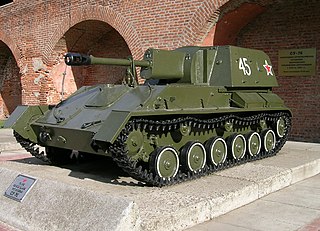
The SU-76 was a Soviet light self-propelled gun used during and after World War II. The SU-76 was based on a lengthened version of the T-70 light tank chassis and armed with the ZIS-3 mod. 1942 76-mm divisional field gun. Developed under the leadership of chief designer S.A. Ginzburg (1900–1943). Its quite simple construction and multipurpose combat role made it the second most produced Soviet armored fighting vehicle of World War II, after the T-34 medium tank.
A table of organization and equipment is the specified organization, staffing, and equipment of military units. Also used in acronyms as 'T/O' and 'T/E'. It also provides information on the mission and capabilities of a unit as well as the unit's current status.
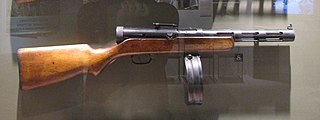
The PPD is a submachine gun originally designed in 1934 by Vasily Degtyaryov. The PPD had a conventional wooden stock, fired from an open bolt, and was capable of selective fire. It was replaced by the PPSh-41.

During World War II, losses of major items of equipment were substantial in many battles all throughout the war. Due to the expense of producing such equipment as replacements, many armies made an effort to recover and re-use enemy equipment that fell into their hands.
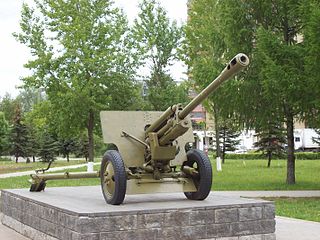
The 76-mm divisional gun M1942 (ZiS-3) was a Soviet 76.2 mm divisional field gun used during World War II. ZiS was a factory designation and stood for Zavod imeni Stalina, the honorific title of Artillery Factory No. 92, which first constructed this gun.

The ZiS-2 is a Soviet 57 mm anti-tank gun used during World War II. The ZiS-4 is a version of the gun that was meant to be installed in tanks. ZiS stands for Zavod imeni Stalina, the official title of Artillery Factory No. 92, which produced the gun first.

The 122 mm howitzer M1938 (M-30) is a Soviet 121.92 mm (4.8 inch) howitzer. The weapon was developed by the design bureau of Motovilikha Plants, headed by F. F. Petrov, in the late 1930s, and was in production from 1939 to 1955. The M-30 saw action in World War II, mainly as a divisional artillery piece of the Red Army (RKKA). Captured guns were also employed later in the conflict by the German Wehrmacht and the Finnish Army. Post World War II the M-30 saw combat in numerous conflicts of the mid- to late twentieth century in service of other countries' armies, notably in the Middle East.
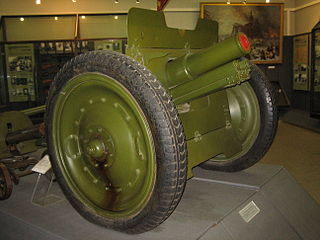
The 76 mm regimental gun M1927 was a Soviet infantry support gun.
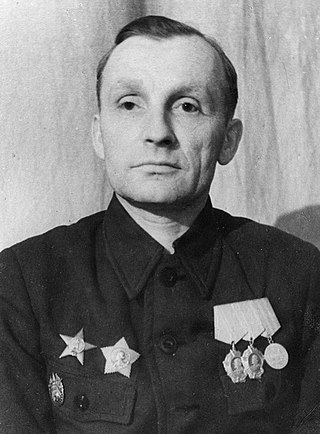
Georgy Semyonovich Shpagin was a Soviet weapons designer. He is best-known as the creator of the PPSh-41, a submachine gun that saw widespread use by the Red Army on the Eastern Front. He also worked with fellow Soviet weapons designer Vasily Degtyaryov on the DShK, a heavy machine gun, shortly before the start of World War II.

The 85 mm air defense gun M1939 (52-K) was an 85 mm (3.3 in) Soviet anti-aircraft gun, developed under guidance of leading Soviet designers M. N. Loginov and G. D. Dorokhin. This gun was successfully used throughout the Second World War against level bombers and other high- and medium-altitude targets. In emergencies they were utilized as powerful anti-tank weapons. The barrel of the 52-K was the basis for the family of 85-mm Soviet tank guns. After the war some 52-Ks were refitted for peaceful purposes as anti-avalanche guns in mountainous terrain.

152-mm howitzer M1938 (M-10) was a Soviet 152.4 mm howitzer of World War II era. It was developed in 1937–1938 at the Motovilikha Mechanical Plant by a team headed by F. F. Petrov, and produced until 1941. It saw combat with the Red Army until the end of World War II and remained in service until the 1950s. Captured pieces were used by Wehrmacht and the Finnish Army. The latter kept the M-10 in service until 2000.

A super-heavy tank is any tank that is notably beyond the standard of the class heavy tank in either size or weight relative to contemporary vehicles.

The 107 mm divisional gun M1940 (M-60) was a Soviet artillery piece, developed in the late 1930s in order to provide Soviet divisional artillery with a powerful field and anti-tank gun. The weapon entered production in 1940, but soon after the outbreak of the German-Soviet War, production ceased; only a limited number of pieces were built. These guns saw service in the Red Army during the war.

ZSU-37 was a Soviet-made, light, self-propelled anti-aircraft gun (SPAAG), developed by the end of 1943 and produced at Works No. 40 in Mytishchi. It was the first Soviet series-produced tracked SPAAG. ZSU stands for Zenitnaya Samokhodnaya Ustanovka, meaning "anti-aircraft self-propelled mount".

The 280 mm mortar M1939 (Br-5) was a Soviet heavy artillery piece used during World War II, it was the Red Army's heaviest field piece during the war.

The PPS is a family of Soviet submachine guns chambered in 7.62×25mm Tokarev, developed by Alexei Sudayev as a low-cost personal defense weapon for reconnaissance units, vehicle crews and support service personnel.

Boris Alexandrovich Vladimirov was a Soviet Army lieutenant general and a Hero of the Soviet Union. Vladimirov served in the Russian Civil War after being drafted into the Red Army in 1921. He became an officer and by 1941 was a deputy regimental commander. After the German invasion of the Soviet Union, Vladimirov successively became senior officer in charge of the formation of march battalions in the Siberian Military District, chief of staff of a ski brigade, and a rifle brigade. He commanded the rifle brigade in the Siege of Leningrad, during the Lyuban Offensive Operation and the Sinyavino Offensive. Vladimirov took command of the 311th Rifle Division in March 1943, leading it until the end of the war. He was awarded the title Hero of the Soviet Union for his leadership in the Vistula–Oder Offensive. Postwar, Vladimirov became a lieutenant general, commanded a rifle corps, and was deputy chief of staff of the Soviet airborne. He retired in 1960 and lived in Moscow.
The 64th Rifle Division was an infantry division of the Red Army during the interwar period and World War II. The division suffered heavy losses in the Battle of Białystok–Minsk but with some troops escaping from encirclement, it was rebuilt in mid-July 1941. For its actions in the Battle of Smolensk it became the elite 7th Guards Rifle Division.

The 29K was a self-propelled anti-aircraft weapon used by the Soviet Union, consisting of a 76 mm air defense gun M1931 mounted on a YaG-10 truck.







